The first part of this article discussed the dimensions of the farrowing house, farrowing pens and crates. In this second part, our experts Heraclio Corchón and Javier Lorente discuss the key issues for the proper functioning of the farrowing house such as the climate control and feeding of the sows.
Feeding system

Feeding the sows in the farrowing house has been defined as an “art”. For large farms, achieving individualized sow feeding control in the farrowing house and the maximum feeding intake for each sow is a true challenge. To help farmers achieve this objective, companies designing livestock equipment have launched different systems in the last few years.
Nowadays it is possible to choose between automatic “conventional” systems with a dispenser; electronic systems for individuallised feeding of both, dry and liquid feeding; gradual ball dispensers to allow for “ad libitum” feeding etc.
Corchón says that it is very difficult to compare all the systems without taking the cost into account, as there is a big difference between them. “One of the key points in pig production is to achieve a high intake in the farrowing house, and for that purpose liquid feeding is the best. Electronic dry feeding in the farrowing house also works well, but it is expensive, and installing them without a probe is a common mistake. Both liquid and electronic feeding systems have the advantage of allowing a feeding curve to be set and, with the probe in the trough, the system decides whether the sow can follow the feeding curve or not. The decision of whether a sow can eat more or not is a very difficult one, but easily solved with these systems.
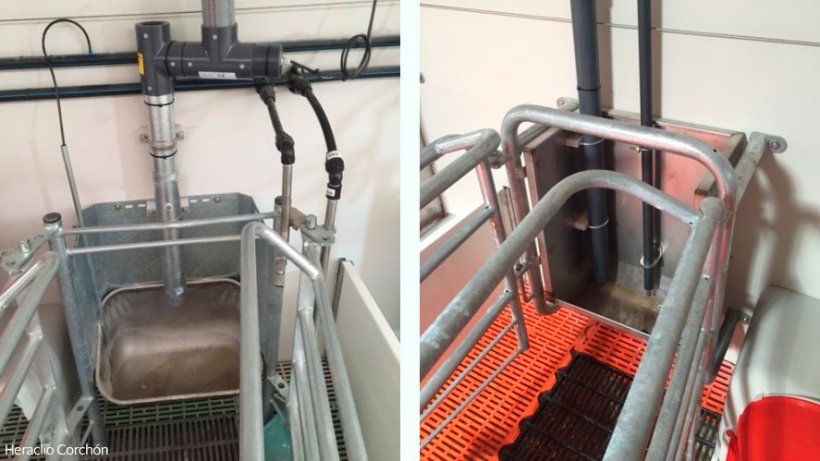
Automatic feeding systems in the farrowing house (both liquid and dry) allow to establish feeding curves, saving the time to daily adjust the dispensers. In both cases it is important to use probes that measure whetherf the sow has eaten the feed provided or not.
“Conventional systems with a dispenser and a trough can also work well, but they need very professional staff who check the troughs daily and decide whether the feed needs to be increased or not”. Ad-libitum systems with a dispenser have some advantages, but I don´t like them as you lose control of the feeding, don´t know if the sow has eaten well or not, do not see her getting up, etc.”
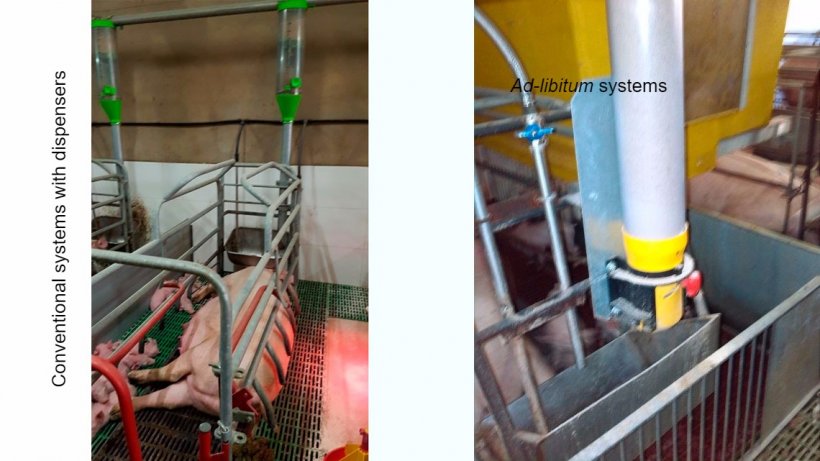
Conventional systems with a dispenser are a good option, but they require a very good level of stockmanship, controlling whether the sows may eat more feed and modifying the dispensers daily. Ad-libitum systems pretend not to “limit” sow intake. Apart from this, feeding at night, when temperature drops, is helpful in warm areas or climates.
Lorente presents himself as a great believer in liquid feeding. –“These days we expect sows to have large intakes in the farrowing house, and I have seen big differences between this system and the others. It certainly does need good management, and to properly adjust the feeding curves, but nowadays for me, this is the preferred system. Automatic electronic feeding systems are also an option, as any system that helps achieving large intakes has to be taken into account, but at a similar price, I prefer liquid feeding”. “Even with liquid feeding, I would place an additional drinker for the sow so it can drink at its freewill” Lorente clarifies,
“What I would not use is automatic feeding systems with only a dispenser; if anything, it should be associated to a hopper that allows for ad-libitum feeding. The systems where the final decision of how much the sow is going to eat relies on the staff, are failing in a very large percentage of occasions, as the desired intake levels are not achieved”.
Climate control
A farrowing house without a good climate control is condemned to fail. The difference between the needs of the piglets (28º-33ºC) and those of the sow (18-22ºC) make it necessary to design systems that allow these two “climates” in the same room. In the first part of this article, it was already mentioned how important creep areas were to warm up piglets without increasing room temperature.
Ventilation
The ventilation design in a farrowing house depends on multiple factors (length and width of the building, etc). Although this article cannot cover 100% of all issues related to correct ventilation for reasons of limited space, our experts support some key ideas:
Ventilation must be forced and climate control must be automatic with the use of probes, controllers and curves.

Corchón says “in most cases the optimal situation is that air enters through a false ceiling. The false ceiling makes air distribution throughout the room easier, prevents drafts, and pre heats the air so it descends at a slower pace. One must bear in mind that if the buildings are over 24 meters this entrance has to be motorized”.

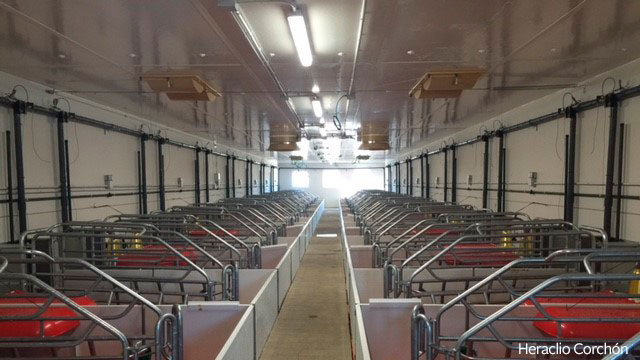
Smooth ceilings without interference to air circulation and air intakes through a false ceiling, preferably motorized if the farrowing rooms are very long, are elements that determine good ventilation.
Lorente points out that we musn’t forget about refrigeration. In warm climates refrigeration by cooling systems is essential.”
Heating systems
Lorente favours the use of creep areas without a doubt, with an electric mat and a self regulating light bulb. “If I can choose and there´s no economic constraints, this is my system. If we have to reduce costs, a creep area with a light bulb and a plastic mat is, without a doubt, a good option. Nowadays we have many alternatives at hand to produce electric power that can lower our costs, with a more efficient system, and we must take advantage of these options”.
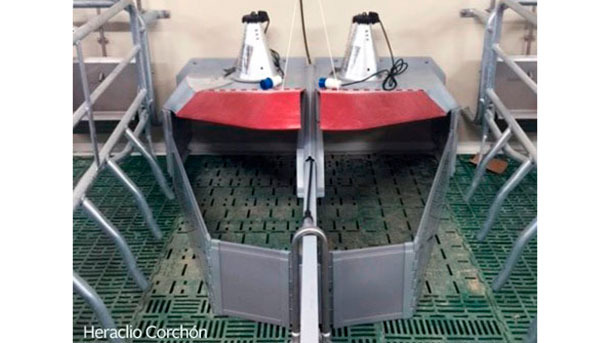
Self-regulating heat lamps and creep areas are a good option to create an adequate environment for the piglet (28-33 ºC depending on their age)
Corchón agrees with this system and adds: –“The mats must be made of plastic or polymer and they must be electric. Mats using hot water are much more inefficient".
Floor types
Corchón comments: –“For the piglets plastic, no doubt, and I also prefer plastic for the sows, as it is less aggressive, and they get fewer sores. I believe it is important that there are at least 60 cm of solid floor at the front, with only a few perforations to let the water that might fall drain easily, thus preventing humidity. With this section of solid floor, we prevent the sow from breathing in the gases from the slurry channel below all day long”.

Farrowing pen with plastic floor for piglets and sow. The floor under the sow is denser at the front.
Lorente agrees with this reasoning but adds: –“However in practice, metal is used under the sow as plastic floor raises doubts amongst farmers”.
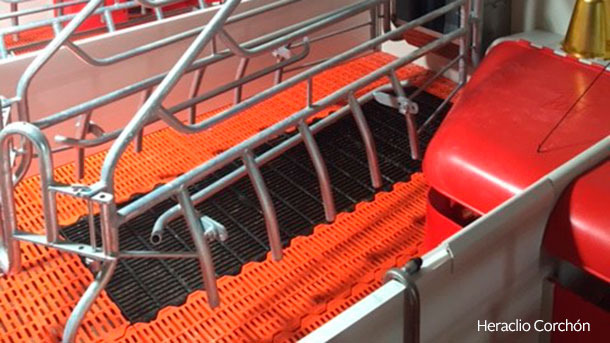
The most commonly used combination is plastic slats for suckling piglets and cast iron for the sow.
Systems to provide milk to suckling piglets
As a final point, we will talk about one of the current issues, the possible need to install systems to provide milk and/or liquid feed to the piglets in the farrowing house.

What use will we give to artificial milk? This is one of the current debates, and although our experts agree it will play a role in the future, they are still not convinced about the use of milk as a system to "rely on".
Both Corchón and Lorente are careful about this subject. Lorente explains: –“Clearly, the use of artificial milk is helpful when dealing with high production levels, but I don´t like it being used routinely. I prefer to look for management systems that do not need to use artificial milk as a permanent tool”.
Designing and building, or refurbishing, a farrowing house forces us to choose between the many available options. There are many issues to deal with and choosing one option or another will determine the way of working and the productive limits of our facilities. Before making any decisions it is very advisable to seek advice from specialists, visit farms and equipment exhibitions, understand the needs of the animals we work with and know what type of management we want to implement.










